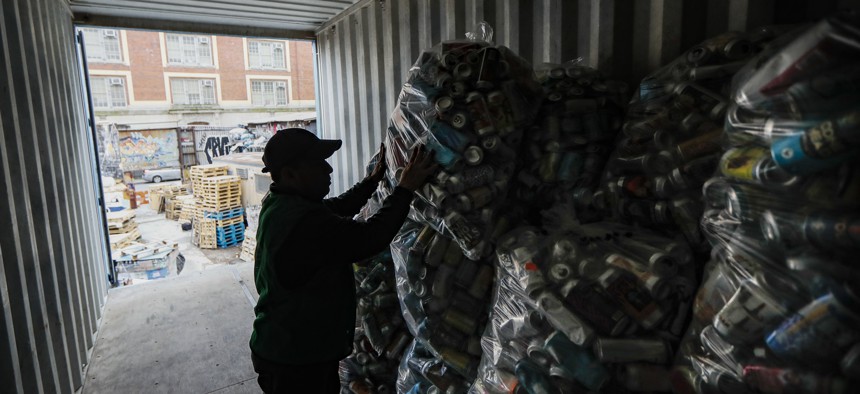EPA National Recycling Strategy Includes Assessment of State, Local Policies

Manuel Rene Del Carmen organizes bags of recyclables on a roof at the Sure We Can, a Brooklyn non-profit redemption center Thursday, Feb. 27, 2020, in New York. AP Photo/John Minchillo
The Environmental Protection Agency released a draft strategy plan this week that proposes a variety of initiatives to improve recycling rates, increase efficiency and improve the market for recycled goods.
The Environmental Protection Agency is considering ways to improve nationwide recycling rates, including the creation of a map of existing recycling infrastructure and an analysis of effective state and local policies.
The ideas are part of the draft National Recycling Strategy the EPA released this week, which the agency expects to use to support future national recycling goals. The strategy focuses on three main objectives: reducing contamination in the recycling stream, increasing the efficiency of materials processing and improving the domestic market for recyclable materials.
“Over the last two years, we’ve heard from our partners about the challenges facing our nation’s recycling system, and in particular for municipal solid waste recycling,” said EPA Administrator Andrew Wheeler. “Our strategy aims to move recycling in America forward by identifying actions that all of us—governments, non-profits, private industry, and the public—can take together.”
The recycling rate in the United States was 35% in 2017, according to the EPA. Only about 11.9 million of the 37 millions tons of recyclable materials that single-family households in the United States dispose of each year are captured through curbside recycling systems, according to the Recycling Partnership’s 2020 State of Curbside Recycling.
The EPA has sought to develop a framework to help boost recycling rates, with particular focus on the issue since China stopped accepting most foreign recyclables, including plastics and paper. That move by Chinahas led to higher costs to recycle materials and some local governments have scaled back curbside recycling programs or stopped accepting glass or other materials.
The EPA strategy recognizes several factors negatively affecting recycling rates, including confusion over what materials can be recycled, outdated recycling infrastructure, inadequate markets for recycled materials, and the lack of a standard way to measure the performance of local recycling systems.
Among some of the recommendations included in the draft strategy, the EPA recommends conducting an analysis of state and local policies that could address recycling challenges.
“State and local governments have adopted various policy approaches to address the challenges facing the recycling system,” the EPA strategy document states. “Conducting an analysis of these different state and local policies for their effectiveness could help inform decision makers nationally.”
Because recycling programs are overseen by local governments, the EPA is best positioned to be able to facilitate the collection of recycling data, said Dylan de Thomas, the vice president of external affairs at The Recycling Partnership. He said state and local governments could review the EPA draft document and assess how it compares to their own recycling goals and the types of strategies that they are missing.
The EPA strategy also recommends creating a national map of existing recycling infrastructure to provide a better picture of key elements of the recycling system. The map would include collection points like drop-off centers, sorting and processing points like materials recovery facilities, and remanufacturing centers like paper mills or glass manufacturing centers. Using information from the national map, a needs assessment of the nation’s recycling infrastructure could be conducted.
“Often, manufacturers are not aware of the recycled material feedstock in their area or aware of the potential to use that material,” the EPA strategy report states. “Communities do not always generate enough recycled material that is worthwhile to transport long distances to other manufacturers who might be able to use the material. One way to help strengthen and increase the use of recycled material as feedstock is by ensuring that manufacturers in the regions where they are generated can take advantage of the available supply.”
Industry groups and other stakeholders are asked to submit comments by December 4 on the draft proposal, which the EPA plans to incorporate into a final document next year.
Andrea Noble is a staff correspondent with Route Fifty.
NEXT STORY: A Warning From Michigan





